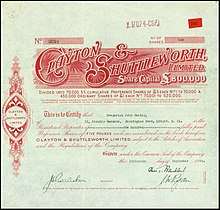Clayton & Shuttleworth
Clayton & Shuttleworth was an engineering company located at Stamp End Works, Lincoln, Lincolnshire, England. The company was established in 1842 when Nathaniel Clayton (1811–1890) formed a partnership with his brother-in-law, Joseph Shuttleworth (1819–83).

History

Steam engines
In 1845 the company built its first portable steam engine, and in 1849 its first threshing machine. These products became the mainstay of its business. Clayton & Shuttleworth became one of the leading manufacturers in the country at the time. It supplied steam engines and threshing machines to other manufacturers, as well as selling under its own name. In 1851 it sold more than 200 steam engines, boosted by the Great Exhibition. By 1857 it had made a total of 2,400 steam engines, and by 1890 total output had reached 26,000 steam engines and 24,000 threshing machines.
Exports
In 1870 the company's workforce in Lincoln numbered 1,200. The export trade was important to the firm; a branch in Vienna (Austria) was established early on, and other branches followed in Pest (Hungary), Prague (now Czech republic), Cracow (Poland) and Lemberg (now Ukraine). The firm became a limited company in 1901, and Alfred Shuttleworth (1843–1925), son of the founder, became chairman.
Internal combustion engines

For a short time in the 20th century Clayton & Shuttleworth made tractors. In 1911 it built a four-cylinder oil engine with car-type radiator, sheet-metal bonnet and cab roof. This was followed in 1916 by a four-cylinder gas-kerosene engine crawler tractor ("Chain Rail"). This 40 horsepower (30 kW) machine was produced until 1929. The company also built a 100 hp (75 kW) gun tractor, similar to a Holt tractor. It was the first British company to make a combine harvester.
Aircraft

In 1916 the company made parts for the Supermarine Scout airship for the Admiralty, and during the First World War it won a number of contracts to build aircraft for both the War Office and the Admiralty.[1] The first contract was to build the Sopwith Triplane; although the War Office later cancelled their contract, 49 were built for the Royal Naval Air Service, with the first Clayton-built aircraft delivered on 2 December 1916.[1][2] The company built the aircraft in the eastern end of the Titanic works, from where they were pushed outside for engine runs. Following ground tests the aircraft were dismantled and taken to Robey's Aerodrome at Bracebridge Heath for test flying and delivery.[3]
In March 1917 the company received a contract to build the Sopwith Camel, and this remained in production until 1919, by which time more than 500 aircraft had been constructed.[4] In 1916 a new works was built to enable the company to produce the large Handley Page O/400 bomber.[4] When completed, the aircraft – unlike the smaller Sopwith aircraft – were flown out for testing and delivery from a field to the east of the works; the field became known as Handley Page Field.[4] After completion of the O/400 contract an order was received to build the Vickers Vimy, but only one was constructed before the Armistice and the contract was cancelled.[5]
Red Baron; Richard Shuttleworth
One of the most notable aircraft built by Clayton & Shuttleworth was Sopwith Camel B7270, flown by Canadian pilot Roy Brown, and officially credited with shooting down the Red Baron Manfred von Richthofen.[6] The company issued a souvenir leaflet after the war to celebrate the success.[6] Modern research indicates, however, that Brown may not in fact have fired the fatal shot.
Richard Ormonde Shuttleworth, the grandson of Joseph Shuttleworth, co-founder of the company, was a noted racing motorist, aviator and collector of cars and aircraft. Cars and aircraft acquired by him formed the basis of what is now known as the Shuttleworth Collection. An officer in the Royal Air Force Volunteer Reserve (RAFVR), he was killed in a night flying accident in World War II.
Aircraft built
- Handley Page 0/400
- Sopwith Camel
- Sopwith Triplane
- Vickers Vimy
Closure

The company failed in 1929, and were taken over by Marshall, Sons & Co. of Gainsborough, for its combine harvester technology. Clayton Forge and the Abbey Works on Spa Road, Lincoln were purchased by Smith's Castings of Coventry in 1929 and became Smith-Clayton Forge Ltd. The Austrian, Hungarian and Romanian branch had been merged into the Hofherr-Schrantz Machine Factory in 1911 creating Hofherr-Schrantz-Clayton-Shuttleworth AG. The company survived the Great Depression in Hungary and the Second World War. After the war the Soviet Red Army occupied Hungary, and the newly formed Communist government started nationalising the industry. The factory became state property in 1948 and was renamed to Vörös Csillag Traktorgyár (Red Star Tractor Factory) in 1951. Its independent operation ceased in 1973 when it was attached to Rába. The factory was finally closed in 2010, however many of the hundred-year-old buildings are still in use by smaller companies.
References

- Walls 1977, page 3
- Walls 1977, page 5
- Walls 1977, page 5/6
- Walls 1977, page 10
- Walls 1977, page 11
- Walls 1977, page 9
Literature
- Baldwin, Nick. Classic Tractors of the World.
- Birch N. (2002/3) Clayton Shuttleworth and Co.- early successes and a strike. Lincolnshire Past and Present, no.50, pp.3-6.
- Moore N (2019), Pictures from Budapest: Who were Hofherr-Schrantz-Clayton-Shuttleworth?, Lincolnshire Past and Present, No.115, Spring 2019, pp. 3-8.
- Ruddock J.G. and Pearson R.E.(1989) Clayton Wagons Ltd.: Manufacturers of Railway Carriages and Wagons 1920-30 Ruddock, Lincoln
- Walls, John (1977). Clayton & Shuttleworth and Marshall Aircraft Production. Lincoln: Control Column.
- Wheeler R.C.(2012) The Rise of Clayton and Shuttleworth, Lincolnshire History and Archaeology, Vol.47, pp. 61-71.
External links
| Wikimedia Commons has media related to Clayton & Shuttleworth. |